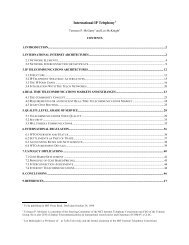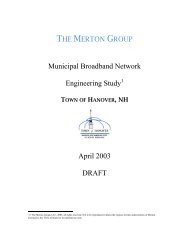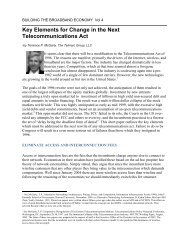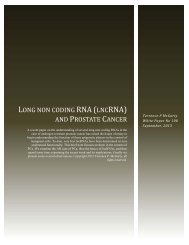progressivism, individualism, and the public ... - Telmarc Group
progressivism, individualism, and the public ... - Telmarc Group
progressivism, individualism, and the public ... - Telmarc Group
Create successful ePaper yourself
Turn your PDF publications into a flip-book with our unique Google optimized e-Paper software.
The <strong>Telmarc</strong> <strong>Group</strong><br />
PROGRESSIVISM, INDIVIDUALISM, AND THE PUBLIC<br />
INTELLECTUAL<br />
An architecture, secondly, is also determined by effectors available, <strong>the</strong>se may be <strong>the</strong><br />
people, technology, <strong>the</strong> financial elements, <strong>the</strong> legal elements, or in <strong>the</strong> broadest sense<br />
what is available to make <strong>the</strong> elements function. People or technology for example places<br />
bounds on what is achievable, however those bounds are typically well beyond <strong>the</strong> limits<br />
that are self-imposed by <strong>the</strong> designer or architect in <strong>the</strong>ir view of <strong>the</strong> user in <strong>the</strong>ir world.<br />
This concept of architecture <strong>and</strong> <strong>the</strong> use of design elements is critical in underst<strong>and</strong>ing<br />
<strong>the</strong> paradigms used in <strong>the</strong> structure of information systems 188 .<br />
World view is <strong>the</strong> most powerful driver in <strong>the</strong> development of an architecture. We argue<br />
in this paper that it is essential to develop a philosophical perspective <strong>and</strong> underst<strong>and</strong>ing<br />
of how to view what <strong>the</strong> architecture implements 189 .<br />
We argue with Winograd <strong>and</strong> Flores, <strong>and</strong> in turn with Heidegger, that we must be thrown<br />
into <strong>the</strong> embodiment itself, to underst<strong>and</strong> <strong>the</strong> needs of <strong>the</strong> users, <strong>and</strong> to underst<strong>and</strong> <strong>the</strong><br />
structure of <strong>the</strong> paradigms that are used to construct <strong>the</strong> world view.<br />
To better underst<strong>and</strong> <strong>the</strong> importance of an architecture we develop <strong>the</strong> concept of <strong>the</strong><br />
historicity of architectures <strong>and</strong> world views based upon <strong>the</strong> classic work of Kuhn <strong>and</strong><br />
<strong>the</strong>n that of McLuhan.<br />
Kuhn begins his <strong>the</strong>sis of how scientific revolutions occur by <strong>the</strong> introduction of <strong>the</strong><br />
concept of paradigms. He defines <strong>the</strong>se as 190 ;<br />
"...<strong>the</strong> term paradigm is used in two different senses. On <strong>the</strong> one h<strong>and</strong>, it st<strong>and</strong>s for <strong>the</strong><br />
entire constellation of beliefs, values, techniques, <strong>and</strong> so on shared by <strong>the</strong> members of a<br />
given community. On <strong>the</strong> o<strong>the</strong>r, it denotes one sort of element in that constellation, <strong>the</strong><br />
concrete puzzle-solutions which, employed as models or examples, can replace explicit<br />
rules as a basis for <strong>the</strong> remaining puzzles of normal science, The first sense of <strong>the</strong> term,<br />
call it sociological, ..., “<br />
The concept of a paradigm is in essence <strong>the</strong> specific example, experiment, demonstration,<br />
that all those who follow a specific <strong>the</strong>ory are explicitly or implicitly relying upon or<br />
basing <strong>the</strong>ir world view upon. The world is flat, man was created out of whole cloth, <strong>the</strong><br />
universe is 4,000 years old, or that <strong>the</strong> speed of light is limited, or that DNA controls all<br />
life. The paradigm is that specific event, experiment, defining moment, from <strong>and</strong> upon<br />
which <strong>the</strong> believes will refer back to <strong>and</strong> build <strong>the</strong>ir world view upon. Thus we return to<br />
TR <strong>and</strong> his Progressive view of <strong>the</strong> Trusts. Yes <strong>the</strong>re were trusts, a few, <strong>and</strong> yes <strong>the</strong>y<br />
controlled some important portions of <strong>the</strong> US industry but <strong>the</strong>re were a few facts that TR<br />
had not paid attention to.<br />
188 See Winograd <strong>and</strong> Flores, pp 34-50, especially <strong>the</strong>ir discussion of Heidegger <strong>and</strong> Throwness in terms of design<br />
189 See Kuhn, pp 72-85<br />
190 see Kuhn p. 175<br />
Page 190












